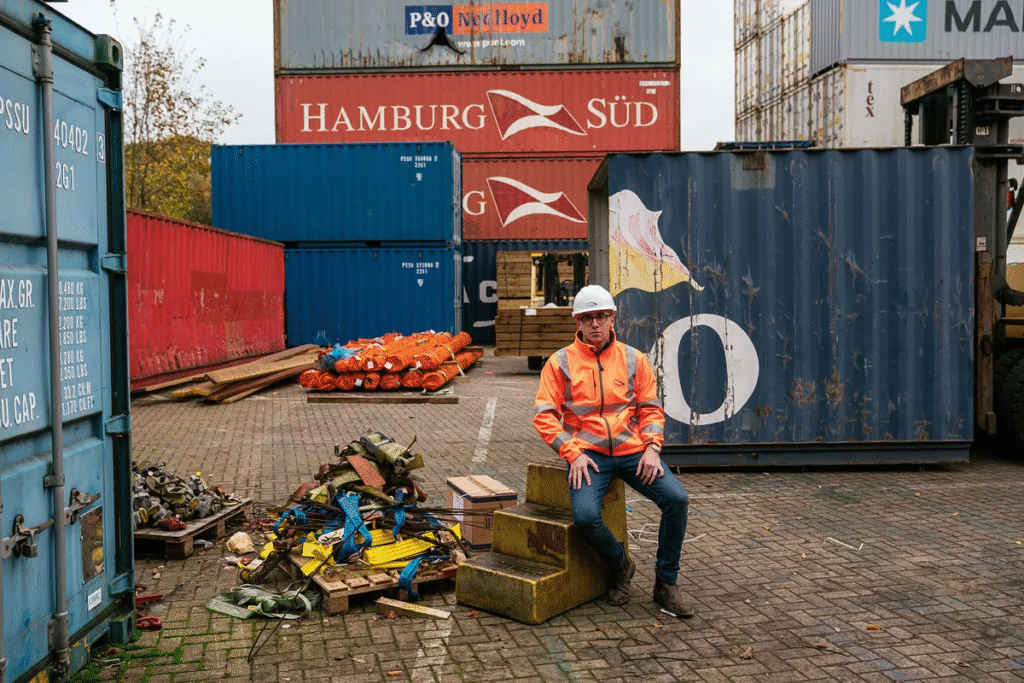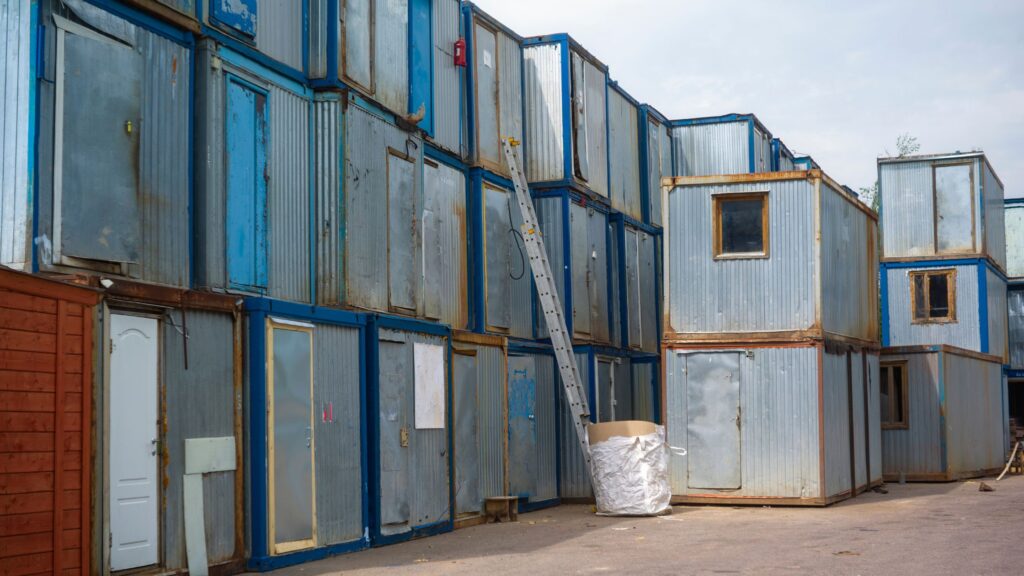Abandoned shipping containers are the foundation of a booming business that’s turning everyday entrepreneurs into millionaires. While these containers pose environmental and logistical challenges for port authorities, they’ve created an unexpected treasure hunt for a new breed of business owners: cargo salvage buyers.

Why Containers Get Abandoned
According to the Sea Empowerment and Research Centre (SEREC), an estimated 100,000 abandoned empty containers are currently littering Nigeria’s seaports as of June, 2025. They estimate that it would cost a ship with a loading capacity of 4,500 TEUs approximately $9 million to freight back empty containers to the origin port. This is considered a significant cost burden on shipping lines.
The abandonment epidemic isn’t unique to Nigeria. Globally, an estimated 3 million containers are idling on ships queued up at ports worldwide, victims of supply chain snarls that have plagued international trade since COVID-19. But what exactly causes these valuable shipments to be left behind?
Financial Pressure
When goods don’t reach their destination on time, they often lose their original value. Seasonal merchandise like electric fans arriving after summer, or construction equipment showing up months after a project deadline, becomes virtually worthless. Sometimes the storage fees exceed the cargo’s value, making abandonment the cheaper option.
Business Failures
Companies go bankrupt, importers disappear, or buyers simply refuse delivery when products don’t meet expectations. In one case documented by cargo salvage buyer Jake Slinn, high-grade leather intended for a private yacht was rejected simply because it arrived creased.
Regulatory Issues
Goods may lack proper import permits, fail quality inspections, or violate customs regulations. In Nigeria, where 45% of containers are reportedly “rickety” and unseaworthy, regulatory compliance adds another layer of complexity.
The COVID Factor
The pandemic dramatically accelerated abandonment rates. Supply chain disruptions meant goods arrived late, businesses closed and consumer demand patterns shifted overnight. What started as a crisis for traditional importers became a goldmine for cargo salvage entrepreneurs.
The Lucrative World of Container Salvage
The numbers tell an incredible story. Take Jake Slinn who told Bloomberg in 2021 the story of how he started JS Cargo & Freight Disposal from his bedroom with just £400 in his bank account. Three years later, his company turns over £500,000 annually, with projections to hit £1 million next year. His two-man operation processes 5-10 containers weekly, handling everything from spoiled food to luxury goods.
“It’s like Storage Wars. You crack the doors open and it’s something completely different than we were expecting. So it’s a challenge. You’re thinking, ‘Right, where can I send this? What can I do with this?’
The profit model is beautifully simple: salvage buyers either pay shipping companies to take containers off their hands or charge disposal fees for worthless cargo. When the contents have value, they resell for profit. When they don’t, they earn money managing proper disposal.
According to Slinn, his other finds included:
- One container labeled simply “household goods” contained a Citroën sedan packed with personal belongings
- A shipment of 50,000 faulty breast implants was shredded and converted to fuel
- Six tons of mystery cheese found new life through anaerobic digestion, generating methane for power plants
- Face steamers, aluminum takeout containers,and designer leather goods all found second lives through salvage networks
The business model scales beautifully.
In another interview, Jack Lear told The Telegraph in 2021 how he pivoted from fancy dress costumes to launching Bargainfox.com and later Jobalots, both focused on unwanted goods. His combined operations turn over £6 million annually, and processed 220,000 pounds of unwanted goods weekly.

Understanding the Business of Cargo Salvage
Container salvage operates within specific legal and logistical frameworks. According to FIATA (International Federation of Freight Forwarders Associations), cargo is considered abandoned when “the consignee has manifested no intention to take delivery after a reasonable period.” This period varies by country—90 days for non-perishables in the US, 60 days in China.
Key Industry Players in the Business:
- Shipping Lines: Want containers back empty to resume operations
- Port Authorities: Need to clear congestion and manage abandoned cargo
- Salvage Companies: Purchase or dispose of abandoned goods
- Secondary Markets: Retailers, wholesalers and specialty dealers who buy salvaged goods
The costs involved can be substantial. SEREC estimates it would cost approximately $9 million for a 4,500 TEU capacity ship to freight empty containers back to origin ports. This economic reality makes local disposal and resale attractive alternatives.
How to Enter the Container Salvage Business in Nigeria
Step 1: Research and Registration Start by registering your business with the Corporate Affairs Commission (CAC). You’ll need proper documentation as freight handlers, waste management, or trading companies often require specific licenses.
Step 2: Build Industry Connections Establish relationships with:
- Port authorities at Lagos, Port Harcourt, and other major ports
- Shipping line representatives
- Customs officials
- Freight forwarders
Step 3: Understand the Legal Framework Familiarize yourself with Nigeria’s Customs Act 2023, which classifies containers under temporary importation (TI). After three months, unclaimed containers become dutiable imports, creating pressure for quick resolution.
Step 4: Develop Disposal Networks Create relationships with:
- Recycling facilities for metal and plastic components
- Food waste processors for organic materials
- Retailers for resaleable goods
- Specialized disposal companies for hazardous materials
Step 5: Start Small and Scale Begin with smaller containers or partner with established operators. Jake Slinn started with just £400 and grew organically by reinvesting profits.

Online Opportunities: The Digital Marketplace
The internet has revolutionized container salvage through online auction platforms:
Major Platforms:
- Salvex: Claims $5.2 billion worth of goods for sale
- Government Surplus Auctions: Many countries sell abandoned cargo online
- Specialized Maritime Auction Sites: Focus specifically on shipping-related salvage
Benefits of Online Operations:
- Lower overhead costs
- Access to global markets
- Detailed inventory management
- Competitive bidding environments
Essential Success Factors
Risk Management
Always inspect manifests carefully, understand local disposal regulations, and maintain proper insurance coverage.
Network Building
Success depends heavily on relationships with shipping lines, port authorities, and secondary buyers.
Market Knowledge
Understanding seasonal demands, local markets, and disposal regulations is crucial.
Financial Planning
Maintain sufficient capital for container purchases, storage fees, and disposal costs.
The Future Outlook
While supply chain disruptions may eventually normalize, container abandonment will likely remain a persistent issue. New variants, trade disputes, economic volatility, and regulatory changes ensure a steady stream of abandoned cargo. Climate change is also creating new opportunities, as extreme weather events disrupt shipping schedules and damage cargo. The growing focus on sustainability makes proper disposal and recycling increasingly valuable.
Conclusion
Nigeria’s 100,000 abandoned containers represent more than a logistical challenge, they’re a business opportunity waiting to be seized. The key lies in understanding the ecosystem, building the right relationships, and approaching each container as both a puzzle to solve and a profit opportunity to maximize. In a world where 90% of goods travel by sea, the stream of abandoned containers shows no signs of slowing down. For those willing to embrace uncertainty and work within complex regulatory frameworks, the abandoned container business offers a unique and interesting path to entrepreneurial success.












